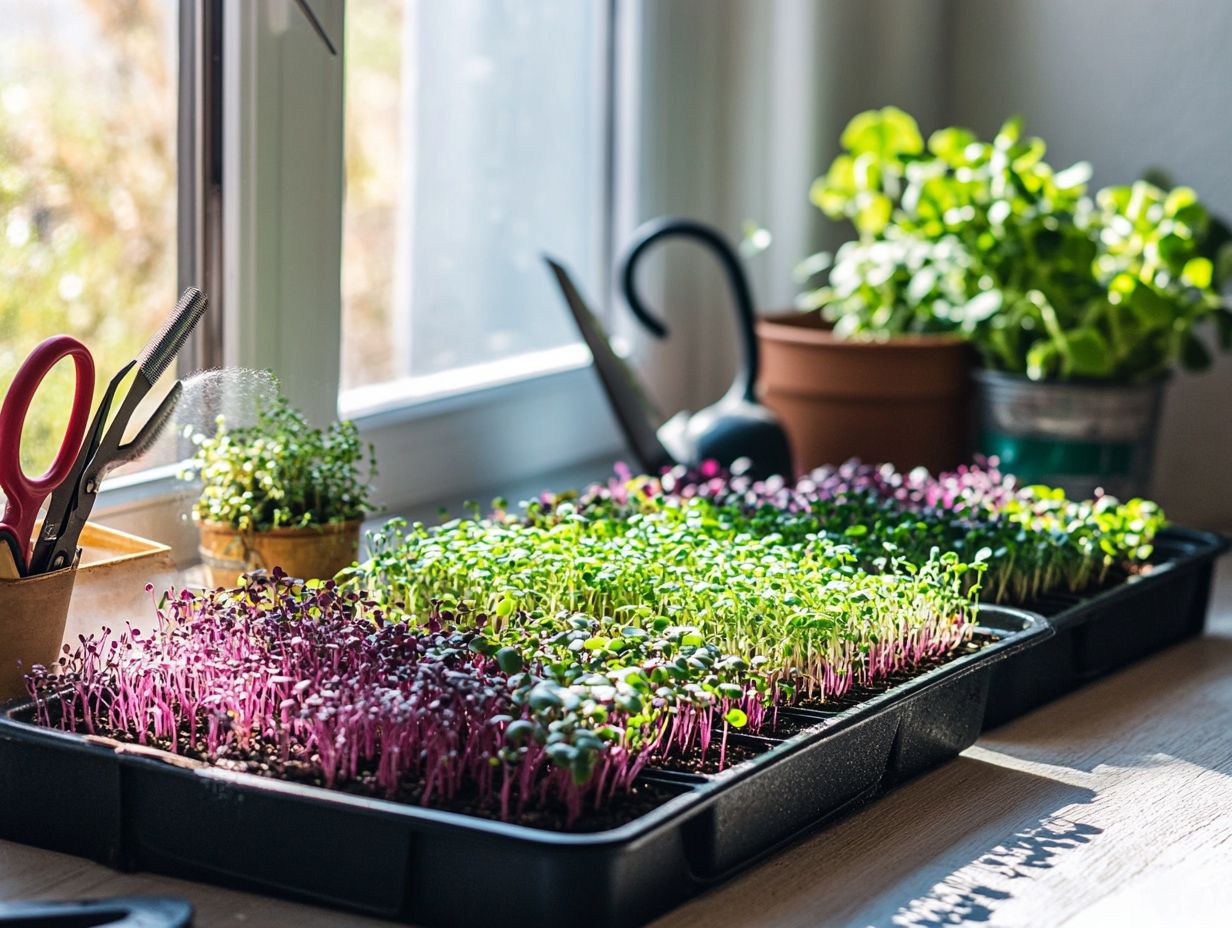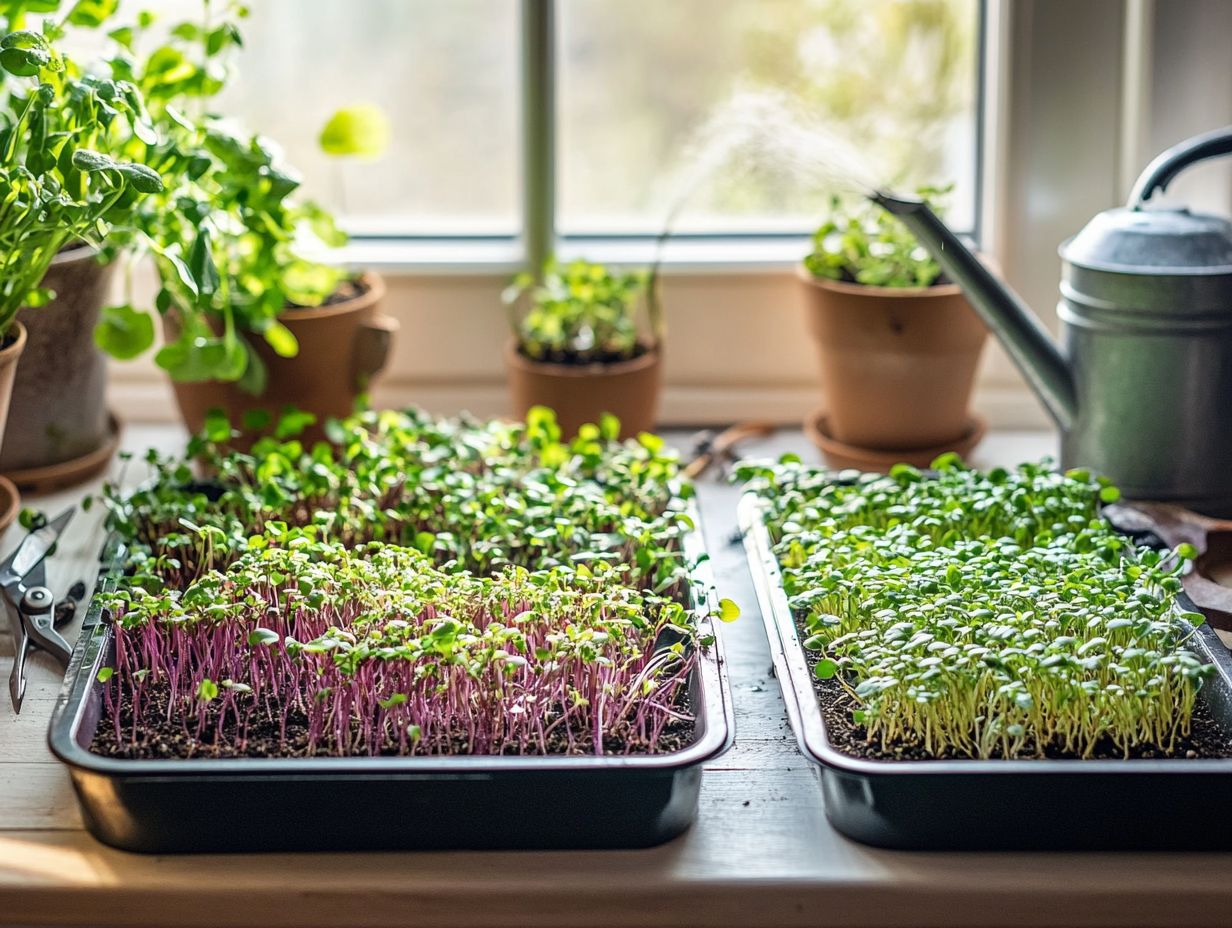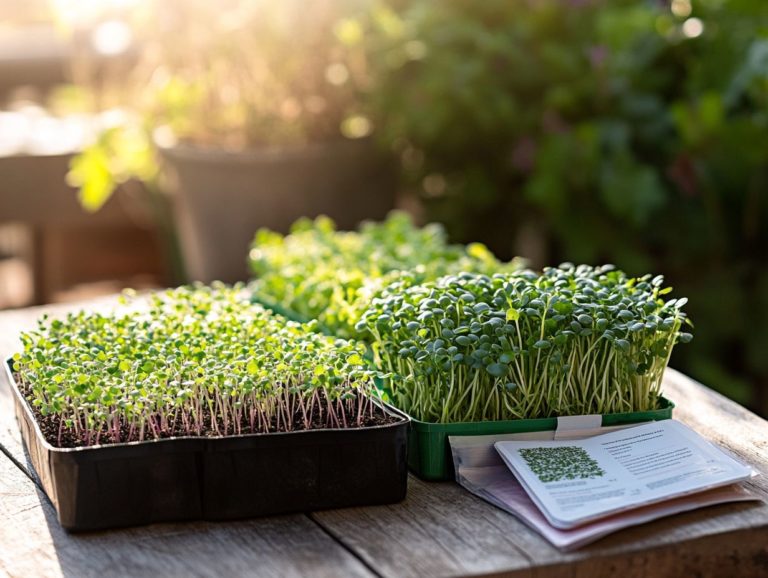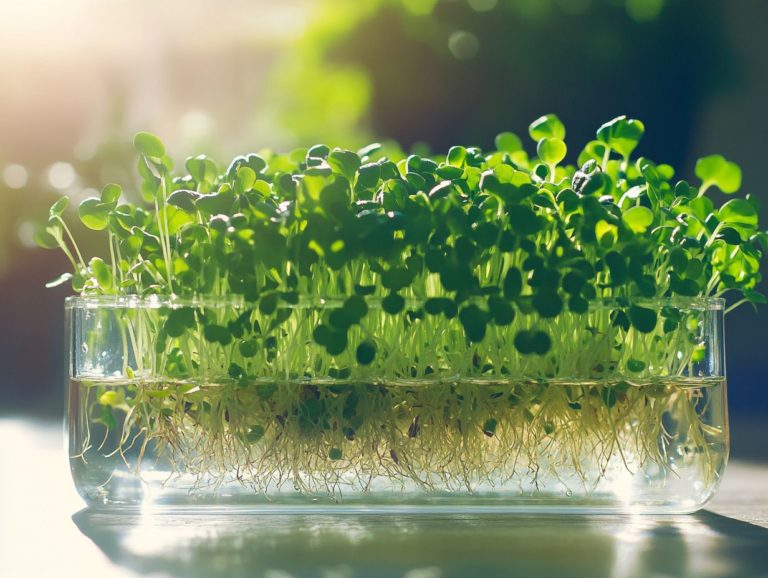Can Microgreens Be Grown Year-Round?
Microgreens are tiny, nutrient-packed plants that deliver a burst of flavor, making them a favorite among health enthusiasts and culinary creators alike.
Get ready to discover the amazing benefits of growing microgreens! From their impressive nutritional value to how they can be part of your home microgreens setup, they also offer cost savings.
Whether you aim to cultivate them indoors or outdoors, you ll find comprehensive guidance on best practices for year-round growth.
Discover which varieties flourish in different seasons and uncover essential tips for nurturing healthy plants in a kitchen garden or indoors.
Dive in to unlock the secrets of microgreen cultivation and elevate your gardening experience to new heights!
Contents
- Key Takeaways:
- Benefits of Growing Microgreens
- Growing Microgreens Year-Round
- Best Microgreens to Grow Year-Round
- Tips for Successful Year-Round Microgreen Growing
- Frequently Asked Questions
- Can microgreens be grown year-round?
- What equipment is needed to grow microgreens year-round?
- What conditions are necessary for year-round microgreen growth?
- Can microgreens be grown in any climate?
- What are the benefits of growing microgreens year-round?
- Are there any challenges to growing microgreens year-round?
Key Takeaways:

- Microgreens can be grown year-round, providing a continuous source of fresh and nutritious greens for your meals, making them ideal for cost-effective gardening.
- Indoor cultivation is a great option for year-round microgreen growing, allowing you to control environmental factors like water and sunlight while eliminating seasonal variations.
- Some microgreens, such as broccoli, kale, and radish microgreens, thrive in colder seasons, while others like sunflower and pea do better in warmer months. Knowing which types suit each season is key for successful year-round growing.
What are Microgreens?
Microgreens are your ticket to vibrant, nutrient-rich flavors, harvested at an early growth stage typically within 7 to 21 days after germination. Imagine adding radish, arugula, and broccoli to your meals, each bite bursting with concentrated flavors and remarkable health benefits.
They re not just easy to grow; they ve become the go-to choice for home gardening enthusiasts, especially those keen on growing without synthetic chemicals and looking to cultivate fresh greens in limited spaces, whether indoors or in a cozy kitchen garden.
Let’s set the record straight: sprouts are just germinated seeds, enjoyed primarily for their crunchy texture and mild taste. Microgreens, on the other hand, are harvested after they ve developed their first true leaves, offering richer flavors and more vibrant colors.
This distinctive growth stage opens up a world of cooking options, making them perfect for garnishing dishes or adding a nutritious crunch to your salads and sandwiches.
With an array of seed options like basil, beet, and sunflower at your fingertips, each variety brings its own unique flavor profile. For instance, radish microgreens deliver a delightful peppery spice, while arugula contributes a nutty richness, elevating the complexity of any dish you choose to adorn with these little green wonders.
Benefits of Growing Microgreens
Growing microgreens presents you with a wealth of benefits, from exceptional nutritional value to cost savings, all while enabling you to savor fresh greens year-round right from your kitchen garden.
These tiny powerhouses are packed with vitamins E, C, K, and antioxidants, making them a remarkable addition to any nutritious meal. Cultivating them with organic methods saves you time and money while creating nutrient-dense greens, even in the most limited spaces.
Start your microgreens journey today and enjoy fresh, vibrant flavors in your meals!
Nutritional Value and Cost Savings
The nutritional value of microgreens is truly remarkable; they can pack up to 40 times more vitamins and nutrients than their fully grown counterparts, making them an excellent choice for anyone mindful of both health and budget.
These petite greens shine with an abundance of vitamins E, C, and K. They also contain a treasure trove of antioxidants and polyphenols, which contribute to their impressive health benefits.
You can save money by cultivating microgreens at home instead of splurging on pricey organic greens at the grocery store. This choice contributes to a more sustainable gardening practice.
Take broccoli microgreens, for instance; they re rich in sulforaphane, a compound found in broccoli that may help fight cancer. Radish microgreens deliver a hefty dose of vitamin C, which is critical for boosting your immune health, while beet microgreens are loaded with nitrates that enhance blood flow and athletic performance.
When you evaluate the costs, homegrown varieties not only spare you the premium often tied to organic packaging but also provide the luxury of year-round harvesting. This ensures you have consistent access to these nutrient-dense superfoods at your fingertips.
Ultimately, investing in a small indoor garden can yield substantial benefits, both financially and for your health.
Growing Microgreens Year-Round

You can easily grow microgreens year-round, and it s incredibly rewarding! No matter if you boast a vast outdoor garden or merely a cozy window sill for indoor gardening, these delightful greens are easy to cultivate. They thrive in various conditions, making them perfect for container gardening.
They offer the enticing prospect of continuous harvesting, providing you with fresh greens throughout the year. By mastering the essentials of watering, seed preparation, and soil preparation, you can savor the advantages of homegrown microgreens, including tips for growing microgreens in winter, no matter the season.
Indoor vs. Outdoor: Where Will You Grow Your Greens?
Choosing between indoor and outdoor gardening will shape your microgreen adventure. Indoor gardening offers the luxury of a controlled environment, allowing you to manage essential factors like water and sunlight with precision. In contrast, outdoor cultivation takes full advantage of natural sunlight and fresh air, enriching your microgreens in their own unique way.
The indoor method is especially beneficial if you’re facing space constraints; containers can be stacked or arranged creatively, making the most of every inch. On the flip side, outdoor gardening taps into a thriving natural ecosystem that fosters growth but comes with its own set of challenges due to weather variability and pests.
If you choose the indoor route, opting for high-quality soil and suitable containers is crucial for promoting better drainage and airflow. Meanwhile, in outdoor settings, timing your planting schedule to align with seasonal changes and ensuring thorough soil preparation can result in vibrant microgreens. For those interested in specific options, exploring seasonal microgreen varieties for year-round growth can help you cultivate a flourishing microgreen garden tailored to your unique circumstances.
Seasonal Variations and Adjustments
Seasonal variations are crucial for your success in growing microgreens. They require tailored care adjustments depending on the time of year. By understanding germination rates and harvest times for different microgreens, you can effectively plan your planting schedule to ensure continuous output.
Stay alert for pest issues that can arise in different seasons. This awareness will help you maintain healthy growth in both indoor and outdoor gardens.
Take spring, for instance it’s a prime time for microgreens to flourish, thanks to increased sunlight and warmth. This season is perfect for planting varieties like basil and arugula.
Conversely, the winter months may require you to use grow lights and temperature controls to keep your delicate seedlings thriving.
Being aware of specific pests, such as aphids or fungus gnats, that may appear during certain seasons allows you to manage them proactively. Techniques like neem oil or companion planting can effectively deter infestations. Knowing this not only boosts your growth but also helps you garden sustainably.
Best Microgreens to Grow Year-Round
The best microgreens to cultivate year-round include a variety of seed types that provide nutrient-dense options and deliver concentrated flavors to elevate any dish.
Choices like radish microgreens and arugula microgreens stand out for their ease of growth and distinctive flavors, appealing to a wide range of culinary tastes. By selecting just a handful of these varieties, you can ensure a steady supply of fresh greens throughout the year using techniques for growing microgreens year-round.
Types of Microgreens that Thrive in Different Seasons

Different types of microgreens thrive in various seasons, giving you the chance to optimize your growing strategies for the best results. For example, radish and arugula microgreens flourish in cooler weather, while varieties like broccoli and kale can be cultivated nearly year-round.
Understanding which microgreens, such as mustard and radishes, perform best in specific climates can greatly enhance your gardening experience, allowing you to enjoy the benefits throughout the year.
During warmer months, heat-loving microgreens like basil and sunflowers take center stage, thriving in sunny conditions with consistent moisture. In more temperate climates, you might find success with slower-growing varieties like beets, which appreciate moderate temperatures.
Creating an indoor growing environment provides stability, allowing for a wider array of microgreens regardless of the season. Recognizing the interplay between climate and specific microgreen needs means you’ll be amazed at how vibrant and nutrient-dense your crops can be all year long! If you’re interested in maximizing your harvest, check out this guide on how to extend the growing season for microgreens.
Tips for Successful Year-Round Microgreen Growing
For successful year-round microgreen cultivation, focus on key factors that foster healthy growth and abundant harvests. Pay close attention to proper watering techniques, good soil, and adequate seedling nutrition, as these elements are critical to your rewarding gardening journey.
By embracing organic methods and maintaining consistent care, you can enjoy a continuous supply of fresh greens, no matter the season. Start your microgreen journey now and enjoy fresh greens all year long!
Key Factors for Maintaining Healthy Growth
To ensure the healthy growth of your microgreens, consider key factors such as proper watering practices and effective soil preparation. Be vigilant against pesky issues that could hinder development.
Understand the specific needs of your microgreen varieties. This will help you tailor your growing approach for the best results. Ensuring appropriate moisture, light, and care can significantly enhance not just the growth, but the overall health of your microgreens.
Watering should be consistent yet cautious; too much can lead to rot, while too little can stunt their growth. A moisture meter, which measures how wet your soil is, can be a valuable ally in this quest.
Regarding nutrient management, providing the right balance of fertilizers is essential. Start with a gentle organic blend that promotes lush growth without overwhelming those delicate plants. Regularly checking for signs of pests like wilting or unusual spots enables you to take swift action. Introducing good bugs that help get rid of pests or using natural deterrents like neem oil can be effective strategies.
Regularly rotate your crops and clean your tools. This practice minimizes pest outbreaks, ensuring your indoor or outdoor microgreen garden thrives beautifully.
Frequently Asked Questions
Can microgreens be grown year-round?

Yes, microgreens can be grown year-round as long as you have the right equipment and conditions.
What equipment is needed to grow microgreens year-round?
To grow microgreens year-round, you will need grow lights, trays, potting soil, and seeds. You can also use a grow tent to create an ideal environment.
What conditions are necessary for year-round microgreen growth?
Microgreens need consistent warmth, humidity, and light to grow year-round. You may need to adjust these conditions depending on the type of microgreens you are growing.
Can microgreens be grown in any climate?
Yes, microgreens can be grown in any climate as long as you have control over the growing environment. This means you’ll need cool gear like grow lights and a grow tent to create the perfect indoor oasis!
What are the benefits of growing microgreens year-round?
Grow microgreens year-round for a nonstop supply of fresh, nutrient-packed greens! It also saves money and reduces waste, making your wallet and the planet happy!
Are there any challenges to growing microgreens year-round?
While growing microgreens year-round is possible, it may require more time and effort compared to growing them seasonally. You also need to ensure that your equipment is in good working condition and maintain a consistent growing environment.






